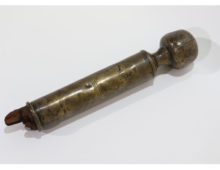Soldier’s Story: Matthew Anderson, a One-Legged Scot
Matthew Anderson (1780-1844) was a native of Neilston, near Glasgow, Scotland. In 1808 he joined the 91st (Argyllshire Highlanders) Regiment of Foot from the Renfrewshire Militia (which he had joined in 1805) as an Ensign. He was made a Lieutenant the following year and in 1810 transferred to the 52nd (Oxfordshire) Regiment of Foot, where he remained for the remainder of the war.
He fought during the Walcheren Campaign and in many battles of the Peninsular War. During the Siege of Ciudad Rodrigo in 1812 he helped lead the company of the 52nd which, in a surprise attack, took Redoubt Renaud.
Anderson was wounded twice before Waterloo, including at the Battle of the Nivelle (1813). One of these wounds was caused “by a spent ball, which entered his ear, ran round between the skin and the flesh, and came out at the back of his neck,” and the other was “through the elbow.”
At Waterloo, Anderson was with the first battalion of the 52nd. When Lieutenant-Colonel John Colborne (later Lord Seaton) , the commanding officer of the 52nd, saw the Imperial Guard advancing in a final push, he ordered Anderson to take a company of about 100 skirmishers to meet the French column, with the 52nd advancing behind them. It was the (apparently unexpected) fire from this company that first caused the halt of the Imperial Guard.
The 52nd skirmishers suffered greatly in this attack, and both officers (Anderson and Lieutenant Campbell) were severely wounded, with Anderson having his left leg shot off. According to an obituary, Anderson
lay on the field for three or four hours; and, while lying there, had his watch, sword, and everything of value about him stolen by a soldier’s wife. An English officer, in pity for his sufferings, tried to tramp him to death with his horse, but the sagacious animal leapt over him, and unhorsed its rider. His leg, after he was taken to the infirmary, required to be amputated three different times.
While Anderson was lying on the field of Waterloo, the 52nd accidently shot into the 23rd Light Dragoons, and he said that he overheard the “commanding officer exclaim, in a tone of vexation, ‘It’s always the case, we always lose more men by our own people than we do by the enemy.’”
Despite his lost leg, Anderson was put on active duty during the occupation of France following Waterloo. In the fall of 1817, the Duke of Wellington finally removed Anderson from active duty and recommended him for half pay. However, the case was not reviewed by the Duke of York (the commander-in-chief of the British army) until the spring of 1818, when the occupation was nearly over.
Anderson was made a Captain of the 52nd in 1821 and retired immediately afterwards. He acquired the family lands of Broadlie in Neilston and devoted the rest of the life to improving Broadlie (from the “garden of the sluggard” to “a fertile field, delightful to look on”) and to encouraging agriculture in Neilston.
Sources
Lionel S. Challis’s Peninsula Roll Call
Leaves from the Diary of an Officer of the Guards (1854), Pages 210-211
The History of Lord Seaton’s Regiment at the Battle Of Waterloo Volumes I & II by William Leeke
The Life of John Colborne, Field-Marshall Lord Seaton, Pages 401, 406-407, 418
The Duke of Wellington and the British army of occupation in France, 1815-1818 by Thomas Dwight Veve, Page 54, citing WO 27/142 (10 October 1817) WO 27/144 (11 May 1818)
Obituary from: The Gentleman’s Magazine, June 1844, Page 669
The New Statistical Account of Scotland, Volume XIV (May 1837), Pages 333-334
The London Gazette:
30 April 1805, Page 4: “Commissions in the Renfrewshire Regiment of Militia”
21 May 1808, Page 4: “91st Foot – To be Ensigns”
10 October 1809, Page 4: “91st Foot – To be Lieutenant”
17 July 1810, Page 2: “52nd Regiment of Foot”
25 November 1813, Page 4 (Nivelle)
04 August 1821, Page 4 (promoted to Captain)
22 September 1821, Page 4 (replaced since retired)


